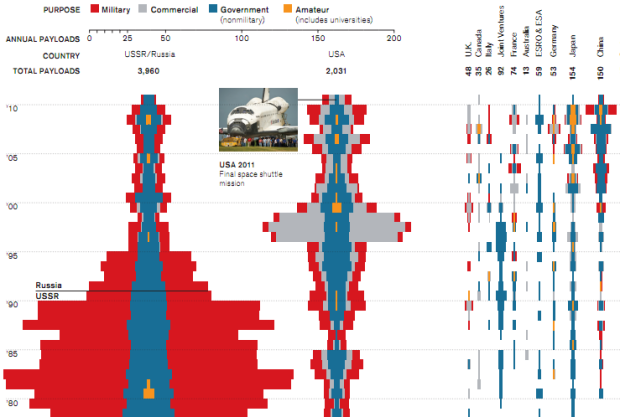With the end of NASA’s human spaceflight program, Tommy McCall and Mike Orcutt for Technology Review explore space launches, since Sputnik 1 went into orbit in 1957. While humans won’t be going up in space for NASA anymore, that doesn’t mean there won’t be anything launching into space.
Of the 7,000 spacecraft that have been launched into orbit or beyond, more than half were defense satellites used for such purposes as communication, navigation, and imaging. (The Soviet Union sent up a huge number, partly because its satellites tended to be much shorter-lived than those from the United States.) In the 1970s, private companies began increasingly adding to the mix, launching satellites for telecommunications and broadcasting.
The stacked bar turned rocket blast aesthetic is a nice touch. Time runs on the vertical and launches are split by country, where USSR/Russia and the United States of course lead the way. The bigger the blast, the more launches for a given country. Color represents purpose of launch. I like it.
[Technology Review via @pitchinteractiv]



I’m not sure how to read the scale. Do I add the left width to the right width and then compare to the scale at the top or is that double counting?
NASA’s human spaceflight program has not ended, just its shuttle program. U.S. astronauts will continue to staff the International Space Station. In fact, NASA is currently recruiting a new class of astronauts to help with these efforts and to train for human exploration beyond low Earth orbit.
I wonder if there was a specific major cause of the huge but short-lived commercial spacecraft launch surge in the late 90’s. Is it the commercial GPS boom? Satellite TV providers?
The surge in the late 1990’s was due to the launch of the satellite communication constellations, including Iridium, Globalstar and Orbcomm. The surge isn’t strictly speakly in the number of launches, but the number of satellites launched (multiple satellites were launched on each launch vehicle for these constellations). The Iridium and Globalstar constellations are used for global mobile communications with 66 and 48 satellites in each constellation respectively (excluding spare satellites that were launched in case of failures)